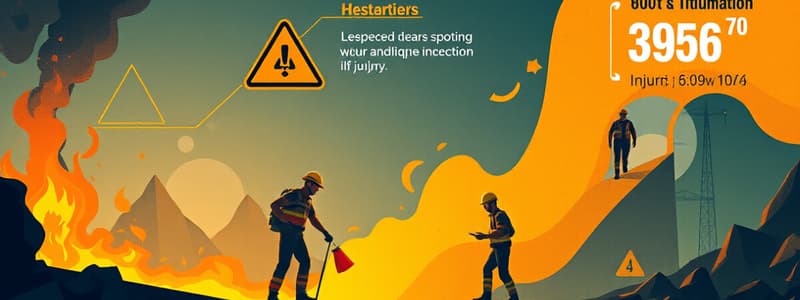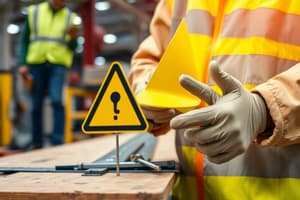Podcast
Questions and Answers
Why is hazard recognition considered a fundamental safety principle in the workplace?
Why is hazard recognition considered a fundamental safety principle in the workplace?
Hazard recognition is fundamental because it helps identify and avoid potential risks before accidents occur, thereby improving workplace safety.
What do the statistics provided by OSHA reveal about workplace injuries and fatalities?
What do the statistics provided by OSHA reveal about workplace injuries and fatalities?
OSHA reports over 3 million injuries and illnesses and more than 4,500 fatalities in workplaces annually, highlighting the significant risks present.
Describe the significance of the Hazard Pyramid Model in workplace safety.
Describe the significance of the Hazard Pyramid Model in workplace safety.
The Hazard Pyramid Model illustrates the relationship between the total number of hazards and varying levels of incidents, demonstrating that reducing hazards leads to fewer accidents.
What are the different types of hazards identified in workplace safety?
What are the different types of hazards identified in workplace safety?
Why is proactive hazard identification important in the workplace?
Why is proactive hazard identification important in the workplace?
How does real-time hazard management contribute to workplace safety?
How does real-time hazard management contribute to workplace safety?
What is the primary objective of accident investigation in the workplace?
What is the primary objective of accident investigation in the workplace?
How can team members contribute to the accident investigation process?
How can team members contribute to the accident investigation process?
Flashcards are hidden until you start studying
Study Notes
Hazard Recognition Overview
- Fundamental safety principle to identify and avoid hazards before accidents occur.
- Hazard recognition involves employers, employees, and supervisors collaboratively improving workplace safety.
Workplace Injury Statistics
- Over 3 million injuries and illnesses annually in the workplace according to OSHA.
- More than 4,500 workplace fatalities each year.
- High hazard workplaces correlate with increased risks and potential accidents.
Hazard Pyramid Model
- A pyramid diagram illustrates the connection between workplace hazards and accidents.
- Bottom: Total number of hazards.
- Level 1: Near misses (1,500 per 20,000 hazards).
- Level 2: Minor injuries (300 incidents).
- Level 3: Major injuries (27 incidents).
- Top: Fatal accidents (1 incident).
- Reducing hazards leads to fewer accidents and injuries.
Types of Hazards
-
Hazardous Conditions: Situations posing risk of harm, including:
- Physical: Risks of falling, being struck, electrocuted, or burned.
- Ergonomic: Related to awkward movements and repetitive tasks.
- Chemical: Involves hazardous materials, flammable substances, and fumes.
- Biological: Risks from viruses, bacteria, and pests.
-
Unsafe Acts: Behaviors that elevate risk, including:
- Using damaged tools or ignoring safety procedures.
- Performing tasks in a hurry without safety measures.
Importance of Proactive Hazard Identification
- Spotting hazards before they cause incidents is critical.
- Use systematic tools:
- Job Hazard Analysis: Review tasks beforehand to identify hazards and create mitigation plans.
- Pre-Shift and Pre-Operation Inspections: Required checks to ensure safety at the start of shifts and tasks.
- Work Permits: Document tasks and risks for high-risk jobs, requiring supervisor approval.
Real-Time Hazard Management
- Constantly assess the working environment for potential risks.
- Look for:
- Physical hazards (ex. spills, poor lighting).
- Ergonomic risks (ex. heavy lifting, awkward movements).
- Chemical hazards (ex. toxic fumes, unmarked substances).
- Report and remedy identified hazards promptly.
Accident Investigation
- The process seeks to uncover root causes behind workplace accidents.
- Even clear unsafe acts can be symptoms of deeper issues, such as equipment inadequacy or systemic problems.
- All team members possess valuable insights that can aid investigations.
Summary of Key Concepts
- Combination of hazardous conditions and unsafe acts leads to accidents.
- Effective hazard recognition minimizes risks through systematic identification and elimination.
- Understanding and acting on recognized hazards promotes a safer workplace.
- Continuous awareness and proactive behavior contribute to long-term safety improvements.
Hazard Recognition Overview
- Identifying and avoiding hazards is a fundamental safety principle aimed at preventing accidents.
- Collaborative efforts among employers, employees, and supervisors enhance workplace safety.
Workplace Injury Statistics
- OSHA reports over 3 million workplace injuries and illnesses each year.
- More than 4,500 fatalities occur annually in the workplace.
- High hazard environments significantly increase accident risks.
Hazard Pyramid Model
- A pyramid diagram illustrates the hierarchy of workplace hazards leading to accidents:
- Total number of hazards forms the base.
- Level 1 showcases near misses, with 1,500 near misses per 20,000 hazards.
- Level 2 displays minor injuries, averaging 300 incidents.
- Level 3 represents major injuries, totaling 27 incidents.
- The apex shows fatal accidents, with just 1 incident.
- Reducing hazards is directly linked to a decrease in accidents and injuries.
Types of Hazards
- Hazardous Conditions include various risks:
- Physical hazards involve risks of falling, being struck, electrocution, or burns.
- Ergonomic hazards stem from awkward postures and repetitive tasks.
- Chemical hazards involve handling hazardous materials, flammable substances, and toxic fumes.
- Biological hazards arise from exposure to viruses, bacteria, and pests.
- Unsafe Acts encompass risky behaviors such as:
- Using damaged tools or neglecting safety procedures.
- Rushing through tasks without safety precautions.
Importance of Proactive Hazard Identification
- Early hazard identification is essential to prevent incidents.
- Systematic tools for hazard recognition include:
- Job Hazard Analysis: Analyzes tasks to identify hazards and develop mitigation strategies.
- Pre-Shift and Pre-Operation Inspections: Routine safety checks at the beginning of shifts and tasks.
- Work Permits: Documentation for high-risk jobs, requiring supervisor approval to outline tasks and risks.
Real-Time Hazard Management
- Continuous monitoring of the work environment for potential risks is crucial.
- Key areas to assess include:
- Physical hazards like spills and poor lighting conditions.
- Ergonomic risks such as heavy lifting and awkward movements.
- Chemical hazards, including unmarked substances and toxic fumes.
- Prompt reporting and resolution of identified hazards is vital.
Accident Investigation
- Investigations aim to uncover the root causes behind workplace accidents.
- Unsafe acts may indicate deeper systemic issues or equipment inadequacies.
- Insights from all team members are valuable for thorough accident investigations.
Summary of Key Concepts
- Accidents arise from a combination of hazardous conditions and unsafe acts.
- Effective hazard recognition minimizes risks through systematic identification and resolution.
- Awareness and proactive measures regarding recognized hazards foster a safer work environment.
- Continuous vigilance and proactive behavior enhance long-term safety improvements.
Studying That Suits You
Use AI to generate personalized quizzes and flashcards to suit your learning preferences.




